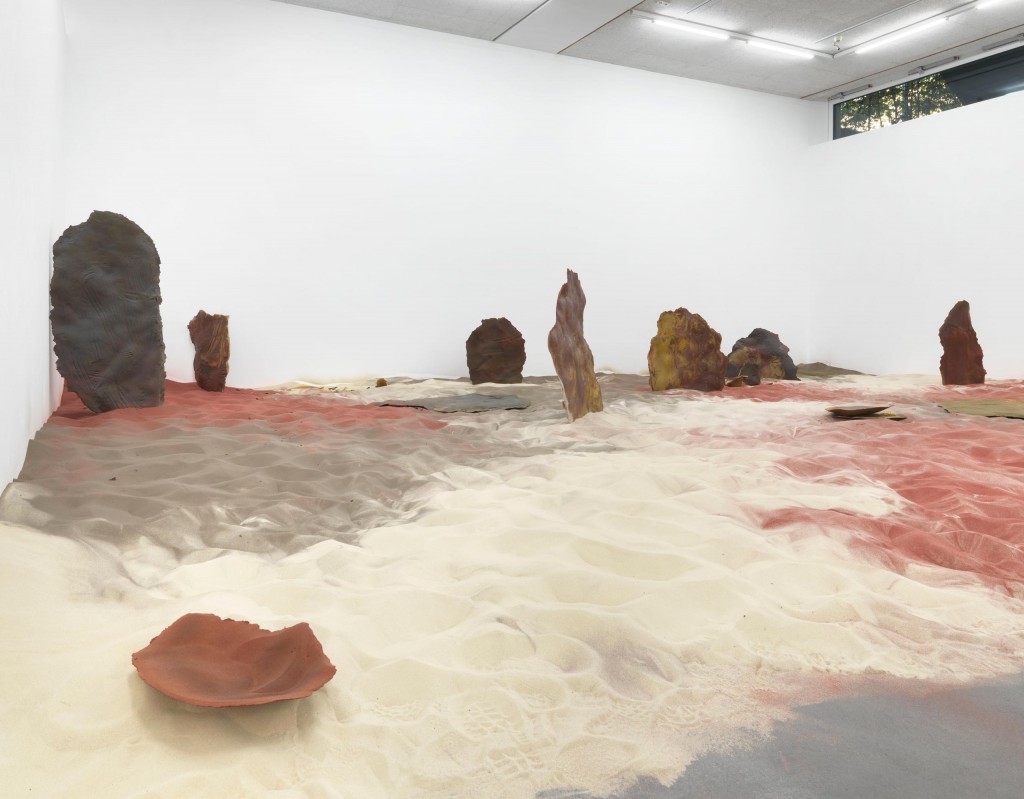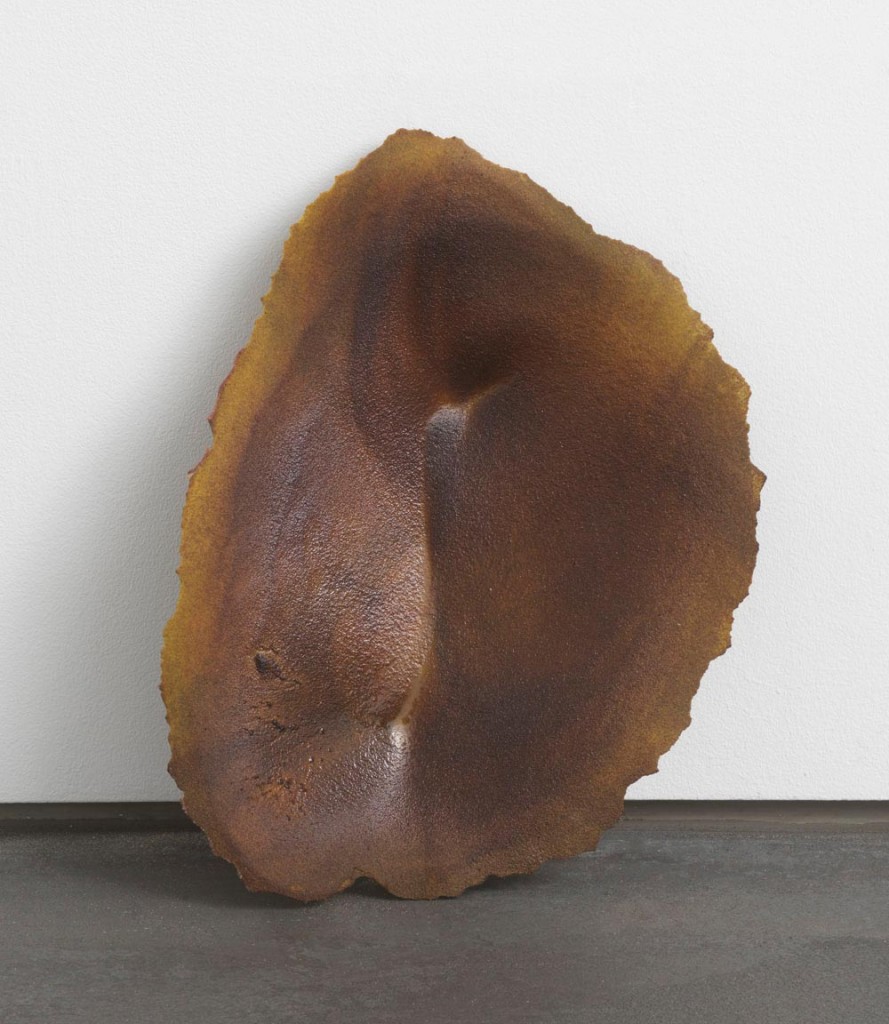DITTRICH & SCHLECHTRIEM is proud to present MOLTEN, the first solo show in Berlin by Italian artist NICOLA MARTINI (b. Florence, IT, 1984 / lives and works in Milan, IT). The gallery is nominated with the exhibition Molten for the VBKI-PREIS BERLINER GALERIEN 2018.
For Molten, Martini executes a complete sculptural and performative installation, filling the subterranean gallery space with 20 tons of phenolic-coated quartz sand, specifically selected for the distinct way the resin coated material melts and binds together when heated. Within this constructed landscape of dark red and yellow toned sand mounds exist a series of individual sculptures, composed of an artist-manipulated version of the same material. Using heat and epoxy to melt, manipulate, and seal the medium, Martini assembles sculptural “crusts” at various scales that contain indentations, footprints, and sand formations documenting the actions of visitors navigating the space over time.
The final “crusts” are then set upright on the sandy floor and repositioned regularly according to the daily schedule of labor. Throughout the course of the exhibition period, Martini continues to manufacture these objects, creating a constantly shifting landscape that offers a different experience for visitors each day.
As evidence of Martini’s ongoing labor, the blowtorch, epoxy supply, and other work equipment remain in the room. Additionally, two new drop-shaped epoxy tank sculptures are mounted on a wall, containing mixtures of demineralized water with either red clay or graphite and metal minerals permanently suspended in a liquid state.
Navigating “Molten”, one can easily see in which way Martini’s work is inspired by the complex and articulated philosophical structure of Maurizio Ferraris’s “new realism.”
(1) Each sculpture reflects his philosophical and material understanding of another realm of perception. Exploring this “new” realm, Martini de-materialises the consistency of the matter he uses, exploiting its chemical properties and deconstructing the forms it is typically used for. In this operation of destructuralisation, Martini’s artistic practice echoes Graham Harman’s materialism. (2) By embracing an object-oriented philosophical approach in his practice, he sheds new light on the nature of materialism.
Over two months, Martini initiates the metamorphosis of the space, assuming the role of a contemporary Prometheus. Throughout the show, the artist heats up portions of the sand, moulding shapes and forms that he randomly places in the space, designing a casual labyrinth of vertical and horizontal primordial forms. The title of the show, “Molten”, is an archaic Middle English form of the past participle of “melt”, which the artist adopts to refer to the archaic, primordial gesture of melting metal as an operation that points to the beginning of technology. The moment in which thermal sand turns from a solid into a liquid state of an undefined shape is one that is suspended in time, and anticipates change and a possible new understanding of reality. Martini understands fusion as a potential moment in time for matter to enter a cycle of regeneration rather than entropy, and this approach is crucial to his artistic reading of the Anthropocene. The installation, hosted in the underground room, becomes a large, elastic vessel in which the essence of an intellectual principle (in this case, matter materialised in the form of thermal sand) exists at different stages and in different shapes, signifying the different stages of existence and conveying new levels of sensorial and intellectual experience.
The above is an excerpt from Molten: Matter through Time, an essay contributed by Irene Campolmi that will be contained in the exhibition catalogue available in the gallery in October 2018. For further information on the artist and the works or to requests images please contact Nils Petersen, nils(at)dittrich-schlechtriem.com.
Nicola Martini has previously been included in our 2017 group show AS IF WE NEVER SAID GOODBYE, as well IN THE LAND OF THE BLIND THE ONE EYED MAN LOSES SIGHT, curated by Julian Charrière in 2015. Martini has exhibited internationally in New York, Paris, and Milan, and was included in INTUITION at the Palazzo Fortuny in Venice, May 2017.
(1) Maurizio Ferraris,Introduction to New Realism, trans. Sarah de Sanctis (London: Bloomsbury Academic, 2015).
(2) Graham Harman, Towards Speculative Realism: Essays and Lectures(Winchester, UK: Zero Books, 2010).
DITTRICH & SCHLECHTRIEM freuen sich, mit MOLTEN die erste Berliner Einzelausstellung des italienischen Künstlers NICOLA MARTINI (geb. 1984 in Florenz, IT / lebt und arbeitet in Mailand, IT) zu präsentieren. Die Galerie ist mit der Ausstellung Molten für den VBKI-PREIS BERLINER GALERIEN 2018 nominiert.
Für Molten setzt Martini eine begehbare skulptural-performative Installation um. Dazu wird der unterirdische Galerieraum mit 20 Tonnen Phenolharz beschichtetem Quarzsand gefüllt, einem Material, das der Künstler wegen seiner besonderen Schmelzeigenschaften und der Fähigkeit, nach dem Erhitzen fest zu verbacken, ausgewählt hat. Aus der künstlich geschaffenen Landschaft aus dunkelroten und gelblichen Sandhügeln ragen einzelne Skulpturen hervor, die durch Bearbeitung desselben Materials entstanden sind. Indem er das Medium mit einem Gasbrenner und Epoxid einschmilzt, manipuliert und versiegelt, lässt Martini skulpturale „Krusten“ in verschiedenen Maßstäben entstehen, in denen Einkerbungen, Fußabdrücke und andere Sandformationen verewigt sind, die im Lauf der Zeit durch die im Raum umhergehenden Besucher verursacht werden.
Die fertigen „Krusten“ werden dann aufrecht auf dem sandigen Boden angeordnet und regelmäßig im Rahmen der täglichen Arbeit versetzt. Martini stellt während der gesamten Dauer der Ausstellung weitere dieser Objekte her und schafft so eine sich ständig wandelnde Landschaft, die den Besuchern jeden Tag ein anderes Erlebnis bietet.
Als Hinweis auf Martinis kontinuierliche Arbeit verbleiben Gasbrenner, Epoxid und andere Arbeitsmaterialien im Raum. Außerdem hängen zwei neue tropfenförmige Behältnisse aus Epoxid an einer Wand; sie enthalten Mischungen aus entmineralisiertem Wasser und roter Tonerde bzw. Grafit und metallischen Mineralien, die so für immer im gelösten Zustand erhalten bleiben.
Beim Gang durch “Molten” ist leicht erkennbar, inwiefern Martinis Werk von der vielschichtigen und weitverzweigten philosophischen Struktur des „neuen Realismus“ Maurizio Ferraris’ inspiriert ist.(1) Jede Skulptur spiegelt sein philosophisches und materielles Verständnis einer anderen Wahrnehmungswelt wieder. In der Erkundung dieser „neuen“ Welt entmaterialisiert Martini die Beschaffenheit des von ihm verwendeten Materials, macht sich seine chemischen Eigenschaften zunutze und dekonstruiert die Formen, in denen es typischerweise zum Einsatz kommt. In dieser für Martinis künstlerische Praxis bezeichnenden destrukturalisierenden Operation klingt Graham Harmans Materialismus an.(2) Indem er sich in seiner Praxis eine objektorientierte philosophische Herangehensweise zu eigen macht, lässt er neues Licht auf das Wesen des Materialismus fallen.
Über zwei Monate hinweg unternimmt Martini eine Metamorphose des Raums, bei der er als ein neuer Prometheus auftritt. Während der gesamten Ausstellungsdauer erhitzt der Künstler portionsweise Sand und modelliert ihn zu Gestalten und Formen, die er zufällig im Raum anordnet, wodurch ein improvisiertes Labyrinth aus vertikalen und horizontalen Grundformen entsteht. Das Wort im Titel der Schau, “Molten”, stammt aus dem Mittelenglischen und ist eine veraltete Form des Partizips Perfekt von „melt“; damit verweist der Künstler auf die archaische und ursprüngliche Geste des Metallschmelzens als eine Operation, die am Beginn der Technologiegeschichte steht. Der in dem Moment, in dem er aus dem festen in den flüssigen Aggregatzustand übergeht und seine bestimmte Form verliert, festgehaltene Quarzsand weist auf bevorstehende Veränderungen und ein mögliches neues Verständnis der Wirklichkeit voraus. Die Verschmelzung, so Martini, kann ein Augenblick sein, in dem Materie in einen Kreislauf der Erneuerung eintritt, statt der Entropie anheimzufallen, und diese Herangehensweise ist entscheidend für seine künstlerische Deutung des Anthropozäns. Die im Ausstellungsraum im Keller eingerichtete Installation wird zu einem großen elastischen Gefäß, in dem die Essenz eines intellektuellen Prinzips (hier in Form von Quarzsand materialisierter Materie) in verschiedenen Stadien und Formen besteht, die für verschiedene Existenzzustände stehen und neue Ebenen der sinnlichen und gedanklichen Erfahrung erschließen.
Der Ausschnitt stammt aus Molten: Matter through Time, einem Aufsatz, den Irene Campolmi für den Ausstellungskatalog beigesteuert hat, der ab Oktober 2018 über die Galerie zu beziehen ist. Für weitere Informationen zum Künstler und den Werken sowie Bildanfragen wenden Sie sich bitte an Nils Petersen, nils(at)dittrich-schlechtriem.com.
Arbeiten von Nicola Martini waren 2017 in unserer Gruppenausstellung AS IF WE NEVER SAID GOODBYE sowie 2015 in der von Julian Charrière kuratierten Schau IN THE LAND OF THE BLIND THE ONE EYED MAN LOSES SIGHT zu sehen, außerdem in internationalen Ausstellungen in New York, Paris und Mailand sowie in INTUITION im Palazzo Fortuny, Venedig, im Mai 2017.
(1) Maurizio Ferraris, Manifest des neuen Realismus, übers. von Malte Osterloh (Frankfurt am Main: Vittorio Klostermann, 2014).
(2) Graham Harman, Towards Speculative Realism: Essays and Lectures(Winchester, UK: Zero Books, 2010).



















